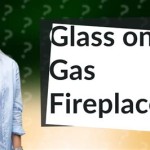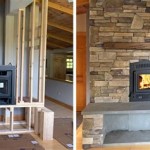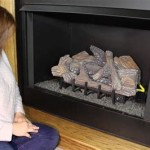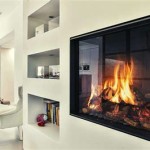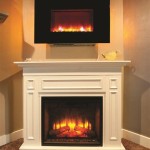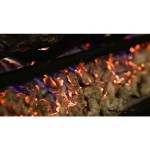Outside Corner Fireplaces: A Comprehensive Guide
An outside corner fireplace represents a distinctive architectural feature, adding both visual appeal and functional warmth to a living space. Unlike traditional fireplaces centered on a wall, these fireplaces are strategically positioned in the corner where two exterior walls meet. This placement offers unique design possibilities, optimizing space utilization and creating a focal point that can be appreciated from multiple angles within a room.
The appeal of an outside corner fireplace stems from its ability to seamlessly integrate with the existing room layout. It can serve as a natural divider between two distinct areas, such as a living room and dining room, while simultaneously enhancing the overall aesthetic. Furthermore, the corner location often allows for more expansive views of the fire, creating a captivating ambiance.
The selection of an outside corner fireplace requires careful consideration of various factors, including the room's dimensions, architectural style, and desired heat output. The material used for the fireplace surround, the type of firebox, and the venting system all play crucial roles in ensuring both functionality and safety. Understanding these aspects is essential for making an informed decision that aligns with specific needs and preferences.
Key Point 1: Design Considerations for Outside Corner Fireplaces
Designing an outside corner fireplace involves more than simply placing a firebox in a corner. It requires a holistic approach that considers the surrounding space, the flow of traffic, and the overall aesthetic vision. The design should complement the existing architectural elements while simultaneously creating a visually striking focal point.
One of the primary considerations is the size and scale of the fireplace. A fireplace that is too large can overwhelm a smaller room, while one that is too small might get lost in a larger space. Proportions are crucial, and careful measurements should be taken to ensure that the fireplace is appropriately sized for the room's dimensions.
The material used for the fireplace surround is another critical aspect of the design. A wide range of materials can be used, including brick, stone, tile, and wood. The choice of material should be guided by the overall style of the room. For example, a rustic-style room might benefit from a stone surround, while a more modern space might call for sleek tile or concrete.
The shape and style of the firebox also play a significant role in the overall design. Traditional fireboxes typically feature a rectangular opening, while more contemporary designs might incorporate curved lines or asymmetrical shapes. The style of the firebox should complement the surrounding materials and the overall design aesthetic.
Furthermore, the venting system must be carefully planned to ensure proper smoke evacuation and prevent any potential hazards. Direct vent systems, which draw combustion air from outside the home and vent exhaust gases directly outdoors, are often preferred for their safety and energy efficiency. The venting system should be installed according to local building codes and regulations.
Integrating the fireplace into the existing room layout is also essential. The fireplace should be positioned in a way that allows for comfortable seating and unobstructed views of the fire. Consideration should be given to the placement of furniture and other decorative elements to create a cohesive and inviting space.
Finally, lighting plays a crucial role in enhancing the ambiance of an outside corner fireplace. Strategically placed lighting can highlight the texture and color of the fireplace surround, while also creating a warm and inviting glow. Dimmable lights can be used to adjust the lighting levels to suit different moods and occasions.
Key Point 2: Fireplace Types and Fuel Options
Selecting the appropriate fireplace type and fuel option is paramount to achieving the desired functionality and aesthetic for an outside corner fireplace. Various types of fireplaces exist, each with its own advantages and disadvantages, and the choice ultimately depends on individual preferences, budgetary constraints, and environmental considerations.
Wood-burning fireplaces are a traditional option, offering the classic ambiance of a crackling fire and the aroma of burning wood. However, they also require a chimney for venting and can be less efficient than other options. Furthermore, wood-burning fireplaces can contribute to air pollution and require regular maintenance, including cleaning the chimney to prevent creosote buildup.
Gas fireplaces offer a more convenient and cleaner-burning alternative to wood. They can be fueled by natural gas or propane and typically feature a realistic-looking log set or decorative glass media. Gas fireplaces are easy to operate, requiring only the flip of a switch or the press of a button to ignite. They also offer precise temperature control and can be thermostatically regulated. However, gas fireplaces require a gas line connection, which may necessitate professional installation.
Electric fireplaces are another option, offering ease of installation and operation. They simply plug into a standard electrical outlet and do not require a chimney or venting system. Electric fireplaces typically use LED lighting to simulate the appearance of flames and can provide supplemental heat. They are a relatively inexpensive option and are suitable for smaller spaces. However, they do not offer the same ambiance as wood-burning or gas fireplaces.
Ethanol fireplaces are a ventless option that burns liquid ethanol fuel. They are relatively easy to install and do not require a chimney or gas line. Ethanol fireplaces produce a clean-burning flame and are considered to be environmentally friendly. However, they may not provide as much heat as other types of fireplaces and require careful attention to safety precautions when handling and storing ethanol fuel.
Each fuel option offers different heat output levels, which should be considered based on the size of the room and desired level of warmth. Wood-burning fireplaces typically produce the most heat, followed by gas fireplaces, then electric and ethanol fireplaces. The efficiency of the fireplace also plays a role in the amount of heat that is retained within the room.
Furthermore, the environmental impact of each fuel option should be considered. Wood-burning fireplaces can contribute to air pollution, while gas fireplaces produce greenhouse gas emissions. Electric fireplaces are generally considered to be more environmentally friendly, especially if the electricity is generated from renewable sources. Ethanol fireplaces are also considered to be relatively clean-burning.
Key Point 3: Installation and Safety Considerations
Proper installation and adherence to safety guidelines are paramount when installing an outside corner fireplace. A poorly installed fireplace can pose significant safety hazards, including fire risks, carbon monoxide poisoning, and structural damage. Therefore, it is crucial to engage qualified professionals to ensure that the installation is performed correctly and in compliance with local building codes and regulations.
The first step in the installation process is to obtain the necessary permits from the local building department. Building codes vary depending on the location, and it is essential to ensure that the fireplace meets all applicable requirements. This may involve submitting detailed plans and specifications for review and approval.
The installation process typically involves preparing the area, constructing the fireplace surround, installing the firebox, and connecting the venting system. The specific steps will vary depending on the type of fireplace and the construction materials used.
For wood-burning fireplaces, the chimney must be properly constructed to ensure adequate draft and prevent smoke from entering the home. The chimney should be regularly inspected and cleaned to remove creosote buildup, which can pose a fire hazard. A chimney cap should be installed to prevent rain, snow, and debris from entering the chimney.
For gas fireplaces, a qualified gas fitter should connect the gas line and ensure that all connections are leak-free. A carbon monoxide detector should be installed in the vicinity of the fireplace to alert occupants in the event of a gas leak or incomplete combustion.
For electric fireplaces, the electrical circuit should be properly grounded and capable of handling the electrical load of the fireplace. Avoid using extension cords or power strips, as they can overheat and pose a fire hazard.
Regardless of the type of fireplace, it is essential to follow the manufacturer's instructions for installation and operation. Never modify or alter the fireplace in any way, as this can void the warranty and create safety hazards.
In addition to proper installation, regular maintenance is crucial for ensuring the safe and efficient operation of an outside corner fireplace. This includes cleaning the firebox, inspecting the venting system, and replacing worn or damaged parts. A qualified technician should perform annual inspections and maintenance to ensure that the fireplace is in good working order.
Finally, fire safety precautions should be observed at all times. Keep flammable materials away from the fireplace, and never leave a fire unattended. Use a fire screen to prevent sparks and embers from escaping the firebox. Have a fire extinguisher readily available in case of a fire emergency.
By carefully considering the design aspects, selecting the appropriate fireplace type and fuel option, and adhering to strict installation and safety guidelines, an outside corner fireplace can become a beautiful and functional addition to any home, providing warmth, ambiance, and a captivating focal point for years to come.

Excellent Corner Outdoor Fireplace Popular Patio Designs Backyard

Outdoor Living Area With Corner Fireplace In Irving Las Colinas Custom Patios

Top 60 Best Patio Fireplace Ideas Backyard Living Space Designs Outdoor Outside

Outdoor Corner Fireplaces
:max_bytes(150000):strip_icc()/01-bf35547a785a442dbaa946d43a3bf24d-c8caf1c8b026428db66baf037bc7a690.jpeg?strip=all)
25 Outdoor Fireplace Ideas That Are Warm And Cozy

Tips For Planning Your Outdoor Fireplace

Saguaro Diy Outdoor Fireplace Plan

Galleries

Vent Free Double Corner Modern Outdoor Fireplace Flare Fireplaces

3 Benefits Of Installing An Outdoor Fireplace Buildometry

